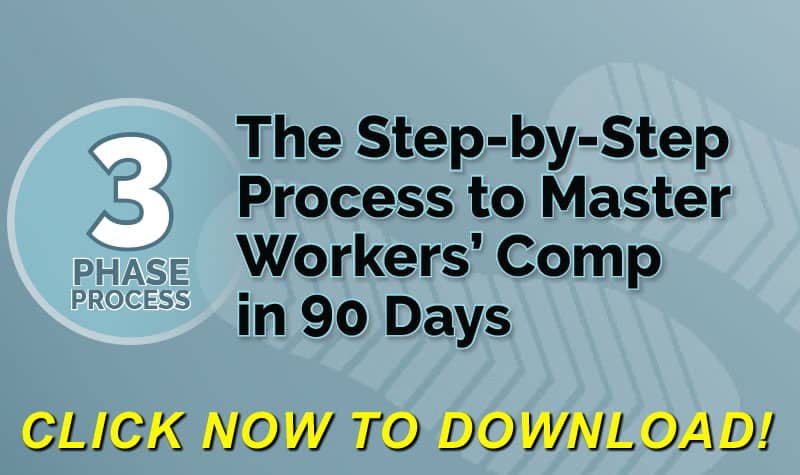
Employees in charge of other workers who view their role in the workers’ compensation process as just an annoyance do a disservice to injured workers and the organization. Employers should take steps to ensure supervisors appreciate the value of the workers’ compensation program and have a thorough understanding of how they can positively contribute to it.
Injury Response
While some organizations have detailed step-by-step plans in place for handling workplace injuries, many don’t; or even if they do, most employees are typically not well versed in the protocol. That’s why it is imperative to continually train supervisors on all the various aspects of the workers’ compensation system and how they fit into it.
Click Link to Access Free PDF Download
For example, if one of your workers went to his supervisor after sustaining an injury, how would the supervisor respond? Would he know, or have a list of steps to follow, a medical provider to treat the worker, if needed? Would he know to address the worker’s medical needs first?
Here are some of the initial procedures supervisors should have down pat:
- Get injured worker medical attention. First and foremost, make sure the worker gets medical attention if needed. If so,
- Where to go
- How to get the worker there; i.e., should he drive himself, and, if not, who should drive him
- What, if anything to take with him
- Communicate appropriately. Extensive research has been done on the impact of a supervisor’s language and tone toward an injured worker. Questioning the truthfulness of the worker, for example, can have a dramatic impact on outcomes. Negativity threatens the worker and research has shown the odds are there will be twice as many days out of work than if there is a positive response from the supervisor.
- Whom to contact. Is there a department/person/number the organization has for reporting injuries? For example, is there a nurse triage system in place?
- Initiate an investigation. While it may not involve a formal inquiry, the supervisor should speak with anyone with possible insight into the accident, such as the injured worker and any witnesses. Having such conversations as soon as possible after an incident is best for getting the most information when it is fresh in people’s minds.
- Take good notes. Any information from the injured worker, witnesses or anyone else who may know about the injury should be written down with as many details as possible. Documentation should include at least the basics — who, what, when, where, why, and how.
After the Fact
Following-up on a workplace accident — or near miss — is also important, as that can go a long way in preventing recurrences. Some actions supervisors can take at this point include
- Determine if any obvious risks contributed to the accident/injury. Walking through the area and talking with other employees who work there can provide insights into potential problems.
- Take corrective action. Any hazards that are obvious should be eliminated as soon as possible, if not immediately. This may require notifying and working with a safety person or other managers. Supervisors should know and be given authority to make simple corrections that can prevent future accidents.
- Communicate the risks and any changes to staff.
The Recovery/Return Phase
If a workers’ compensation claim has been filed and the employee is not working, the supervisor’s role should be one of support. The injured worker needs to know he is a valued employee and the organization wants him back at work. If the supervisor has a positive relationship with the worker, she can take the following steps:
- Initial contact. The supervisor should make the first-day phone call to the injured worker — ask how he is doing, how he feels, and find out what he needs. This is also the time to let the injured worker know what to expect; how/when medical treatment will be provided, who will contact him and for what reason(s), how and when he will receive money, and other aspects of the claims process.
- Ongoing communication. The first-day phone call is extremely important, but the contact should not end there. The supervisor should stay in touch with the injured worker on a continuing basis, through conversations and by sending get-well cards. In addition to finding out how the worker is progressing, these conversations can provide insight into the worker’s mood and whether he is engaged in his recovery. The supervisor should also relay the latest workplace happenings, so the worker feels kept in the loop.
FREE DOWNLOAD: “Step-By-Step Process To Master Workers’ Comp In 90 Days”
- RTW/Transitional duty. Supervisors should be trained on the benefits of returning an injured employee to work as soon as possible, that it is not only best for the organization from a financial standpoint, but usually is best for aiding the worker’s recovery. If the employee cannot return to full duty or his usual work tasks, there should be some type of modified or transitional duty available. The supervisor should be an integral part of this — finding/designing opportunities and guide the injured worker through the process, such as getting the medical restriction information from the treating physician.
Conclusion
Well-run workers’ compensation programs protect employees and save money for their organizations. The supervisor is in the best position to make sure a worker who does get injured has a smooth experience. Therefore, it is vital to make sure they are well trained in all aspects of the program.

Author Michael Stack, CEO Amaxx LLC. He is an expert in workers’ compensation cost containment systems and helps employers reduce their workers’ comp costs by 20% to 50%. He works as a consultant to large and mid-market clients, is a co-author of Your Ultimate Guide To Mastering Workers Comp Costs, a comprehensive step-by-step manual of cost containment strategies based on hands-on field experience, and is founder & lead trainer of Amaxx Workers’ Comp Training Center.
Contact: mstack@reduceyourworkerscomp.com.
Workers’ Comp Roundup Blog: https://blog.reduceyourworkerscomp.com/
©2018 Amaxx LLC. All rights reserved under International Copyright Law.
Do not use this information without independent verification. All state laws vary. You should consult with your insurance broker, attorney, or qualified professional.
FREE DOWNLOAD: “Step-By-Step Process To Master Workers’ Comp In 90 Days”














